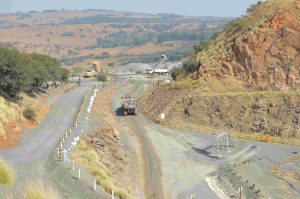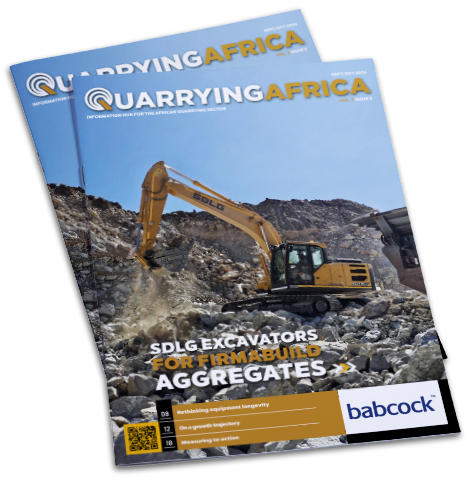Established in July 2019, ERG Industrial has over the past five years changed the face of blasting, a critical parameter in the quarrying and mining value chain. Reflecting on the journey thus far, Preis says the past five years have been a learning curve for the company.
Commenting on some key observations made during that time, Preis says one that quickly comes to mind is the lack of proper QA/QC procedures in both the mining and quarrying sectors, which has led to the introduction of a new consulting division within ERG Industrial.
“QA/QC is one the most important, if not principal, factors in successful blast outcomes at any opencast mine,” he says. “By neglecting this basic function in their blasting processes, quarries and mines are ‘leaving money on the table’ – a hefty amount of money for that matter.”
This, he says, is true for some of the biggest mines in South Africa. At one of the flagship mines in the country, ERG Industrial discovered that compliance to charge heights was only 8%. Only 8% of the holes were within an “acceptable” deviation of 10% and the rest were massively overcharged or undercharged – a recipe for poor blast outcomes.

Gap analysis
To help mines and quarries improve their QA/QC, ERG Industrial has developed a Drill and Blast Gap Analysis tool which allows the team to investigate every single aspect of the drill and blast value chain in order to unearth any potential issues and facilitate continuous improvement. “We use the gap analysis tool to identify opportunities to make small improvements that have the potential to achieve massive outcomes,” says Preis.
Using this method, ERG Industrial has changed the fortunes of a quarry that was previously struggling with poor blast outcomes. “The first thing we did was to ask to be involved in the whole process, from the staking out of the block for drilling, to the firing of the blast to observe their QA/QC,” says Preis.
On the first blast, ERG Industrial discovered some massive discrepancies. For example, the stemming length was supposed to be 3 m as per the blast design, but only 30% of the holes were within the acceptable 10% deviation. There was also a massive discrepancy between the stipulated hole depth and what the contractor had drilled. After presenting these findings to both the quarry owner and the blasting contractor, an action plan and related key performance indicators (KPIs) were drawn up for the next blast, imposing at least a 5% deviation on all parameters.
“The next blast went much better than the first one,” says Preis. “By continuously identifying opportunities for continuous improvement, the third blast was the best ever in the history of the quarry. Bear in mind that this was achieved by not changing the blast design, but just the extra attention to QA/QC. We advised the contractor to take at least a day extra, for example, to drill the block and then measure to ensure that every hole is of the correct depth,” explains Preis.
After these QA/QC initiatives, the quarry has no need for a pecker anymore, even on a 500-hole blasting block. The key takeaway here is that operations can unleash massive gains by prioritising QA/QC without spending a cent more on their blasting budget. In the quarrying industry, oversize is the ‘devil’ because the objective is to crush material as fine as possible. You can imagine the cost implications of setting off a blast and then have a pecker 24/7 to deal with the boulders.
“Operations can add value by putting a ‘magnifying glass’ on their processes and the execution of blasts. I have always said, especially with regard to quarries, if you really want to see improvements, forget about the fancy technology. Go back to basics, get your house in order and develop your KPIs for your contractors around QA/QC. Even appointing someone in-house to manage this aspect would not be as costly as the losses incurred through poor blasts,” says Preis.

The value of electronics
Another key observation, says Preis, is that most operations have moved from pyrotechnic to electronic blasting systems. However, he says, the majority of these operations are not capitalising on the full potential of the electronic systems.
One of the major benefits and a principal reason for adopting electronic blasting systems is the flexibility of timing. Unlike the traditional shock tube solutions, electronic blasting systems allow blasting contractors to be creative with timing.
With electronics, he says, it is a blank page, i.e. one can choose one’s own timing, even at an individual hole level. Despite this obvious flexibility, more than half of the sites that use electronics are still using shock tube timing.
“They deploy electronic blasting technology – which is generally up to five times the cost of shock tube – but they are still timing it the shock tube way. That is mainly because of the lack of knowledge and experience with the new technology,” he says.

Value in confinement
Preis has also observed a growing understanding of the value of energy confinement in blasting, with many in the industry realising that stemming should not be an afterthought. In blasting, he says, energy follows the path of least resistance and, in most cases, it is right up and out the blasthole. Good stemming therefore creates more resistance at the top of the blast hole and directs the energy to where it is needed – the rock mass.
“We do see a trend where people are starting to focus more on energy confinement in blasts. Several operations are now paying more attention to the quality of their stemming and realise that it is not just a matter of throwing any material in the hole to resist the force,” he says. “The knock-on effect of better energy containment is significant. On the health and safety side, there is a marked reduction in flyrock, noise and airblast. From a productivity point of view, there is an improvement in fragmentation. Good stemming is thus a principle of creating better resistance in the blast hole, leading to a range of benefits.”
Change in behaviour
Another trend of note, says Preis, is the change in behaviour by suppliers to the mining sector, particularly relating to explosives providers. Some five years ago, he says, many of the explosive suppliers were prioritising volume over value. The KPI for the explosive provider’s site manager, for example, was to push certain tonnes of product per month.
“In recent years we have seen a shift from that attitude. Explosive suppliers are now driven by the need to create value for the customer, not only pushing volumes. It is true not just for explosive providers, but all the other suppliers in the mining value chain. Creating value for the client has become important. There is this apparent shift from pushing volumes to pushing value. That is the narrative we have always created with our own business from the very start – we are not in it to make a quick buck, but we are there to offer value to our clients for the long haul,” concludes Preis.







